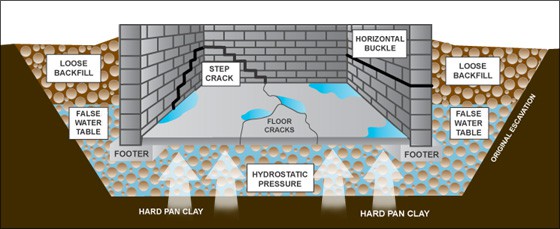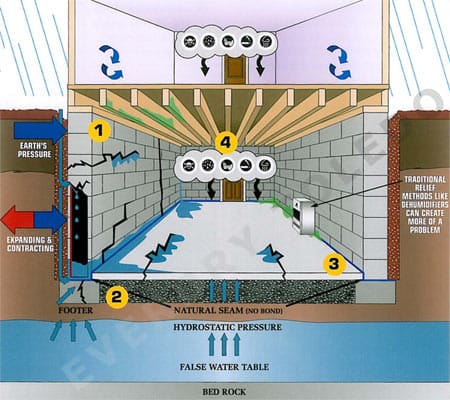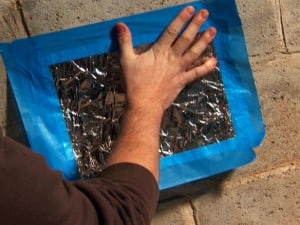Basement waterproofing is big business in Toronto. Between the age of the homes, the extreme weather between seasons, and the fact Toronto sits on top of underground waterways, most homes in Toronto experience water leaking into their basements at one time or another.
If you’re confused about the difference between interior and exterior waterproofing and when each method is appropriate, you’re not alone. The best way to decide which method would work best for your situation is to start by determining the source of the moisture and evaluating the severity of the leak. Below is a quick overview of the two methods:
What is Interior Waterproofing?
Interior “waterproofing” is not truly waterproofing – it’s actually water management as the problem is addressed after the water has already found it’s way through the foundation. This method continues to allow water to enter through the wall, and consequently, the property is not protected from frost or erosion. In a nutshell, this method diverts water away from the basement using a weeping tile system.
When Should the Interior Waterproofing Method be Used?
The interior basement waterproofing method is ideal for homeowners who are concerned about disturbing the outside appearance of their home, as it ensures that landscaping is not harmed in the process. Best used on concrete or structurally sound walls, the interior waterproofing method is usually used to temporarily manage small leaks. It’s also a good solution when excavating is not possible because of factors like lack of accessibility or exterior utilities. Whenever possible, waterproofing from the outside is recommended since long term water entering your basement can lead to erosion of your foundation as well as chronic damp issues in your basement. Plus, if your sump pump ever fails, especially on vacation, the results could be disastrous if you do not have a proper sump pump backup system installed.
What is Exterior Waterproofing?
The exterior basement waterproofing method involves excavating and exposing the foundation wall. The exterior wall is then cleaned and inspected for cracks. Once excavated, the walls are sealed with waterproofing membrane and new drainage (weeping tiles) are placed at the side of the footing. Exterior waterproofing structurally ensures the life of the foundation and the building it supports. Exterior waterproofing stops water from entering the home and protects the property from frost and foundation erosion. Rather than installing a membrane inside the basement to manage the flow of water, the exterior method allows large gaps and cracks to be repaired. Once proper waterproofing coatings are applied they stay flexible and move with the wall, preventing future leaks. Exterior waterproofing is the most popular type of waterproofing we do here in Toronto, but sometimes the exterior of your home or budget excludes it as an option.
When Should the Exterior Waterproofing Method be Used?
Whenever possible, it’s best to work from the exterior to waterproof your foundation to ensure the wall does not erode and remains structurally sound. When your wall is made of cinder-block, stone, bricks or aging concrete the exterior method is also recommended. And of course if the leak in the foundation you’re experiencing is serious and cannot be properly managed with weeping tiles from the inside of the home, external waterproofing is the sensible option. Exterior waterproofing is a permanent, final solution to your basement waterproofing problems and should be your option when budget and logistics allow for it.
Choose the basement waterproofing method that will work best for your Toronto home
In summary, the exterior waterproofing method structurally ensures the life of the wall and the building it supports. The interior waterproofing method, on the other hand, simply manages the flow of water with the use of weeping tiles. If the leak is serious and excavating the foundation wall is a viable option, the exterior method is highly recommended.
Do you have questions about which method will work best for your situation? Feel free to contact us here with any questions. Nusite waterproofing is a basement waterproofing company serving Toronto and the GTA. We offer free in-home waterproofing inspections and estimates.

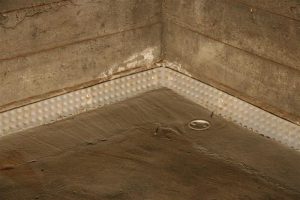
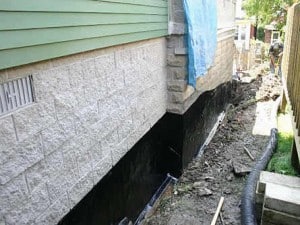
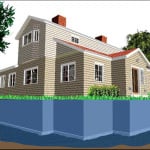 False water tables can spell trouble for your basement or crawl space, even when these areas are waterproofed. As a homeowner, it can be frustrating when water keeps seeping into these areas when you thought you were protected. Here in Toronto, almost all homes have basements and with the weather conditions and underground waterways running through Toronto, water seeping into the basement is a constant issue for Toronto homeowners.
False water tables can spell trouble for your basement or crawl space, even when these areas are waterproofed. As a homeowner, it can be frustrating when water keeps seeping into these areas when you thought you were protected. Here in Toronto, almost all homes have basements and with the weather conditions and underground waterways running through Toronto, water seeping into the basement is a constant issue for Toronto homeowners.